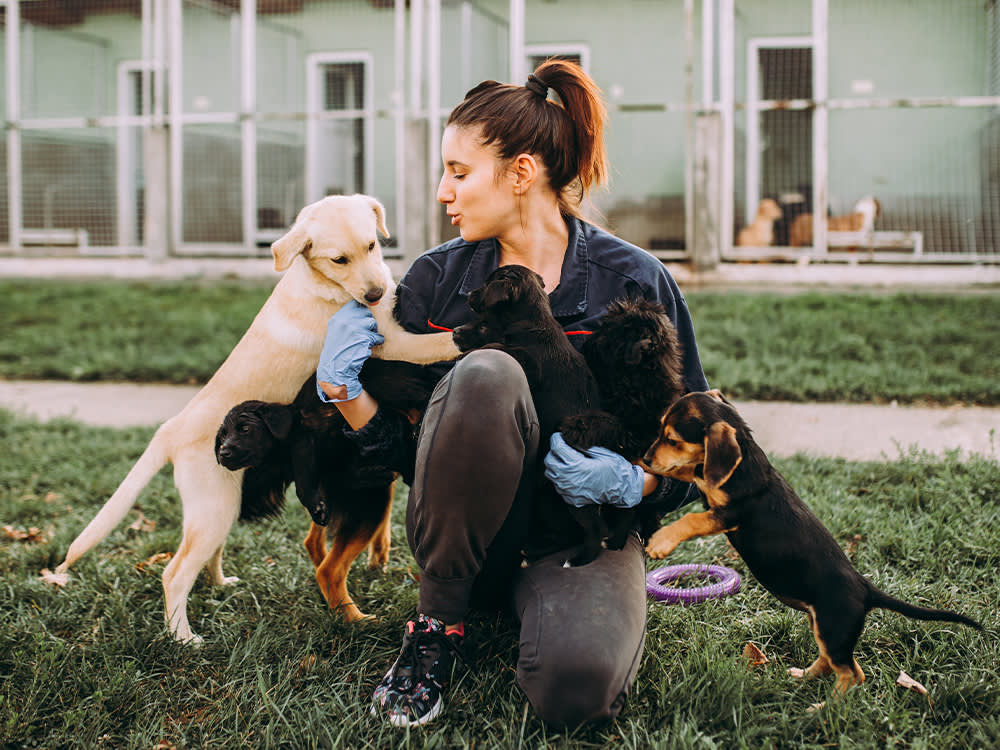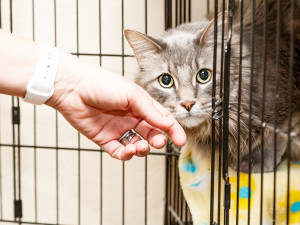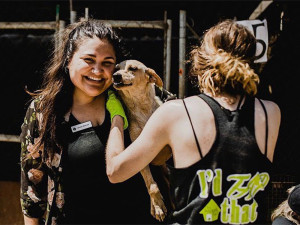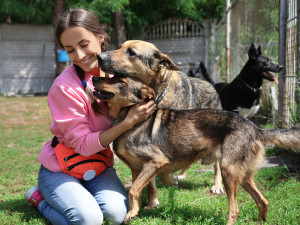10 Ways Animal Shelters Are Upping Their Game
New trends we can totally get behind.
Finally, some good news! In many parts of the country, animal shelters are doubling as places that are able to do more to benefit the communities they serve. The days when abandoned companion animals were simply housed, fed, and kept out of harm’s way while awaiting adoption are becoming a thing of the past, as evidenced by several developing trends pet parents should be pretty psyched about.
Comfy Bedding, Calming Music, and Other Amenities
Shelters are far more animal-centric than ever before. The best of them have evolved into community centers focused on animal welfare — places devoted to training, behavior modification, research, community outreach, and educational programs. Piped-in music, rotating sensory stimulation, manners training, play groups, enrichment, more comfortable bedding, more activities, better spaces: shelters are working to improve life for the animals in every way and at every stage of the experience.
Fancier Facilities
One big way that shelters are doing this is by building new facilities with animals’ needs and comfort in mind. According to Jenn Barg, MS, ACAAB, CDBC and director of operations at Colorado’s Larimer Humane Society (LHS), “The trend is to design shelters so that they provide natural light and reduce stress by the design of the kennels and the rooms where the kennels are located.” At LHS, a 40,000-square-foot facility situated on 22 acres that opened in 2017, every area that houses dogs and cats has natural light provided by windows or solar tubes. The goal, Barg says, is to make the sheltering space “conducive to the animals having a better stay.”
“People in the sheltering world are paying attention to how to build a facility designed around the animals’ needs and behaviors rather than to make it easier to clean or simply to maximize the number of animals that can be held at one time,” Barg adds. “Better-designed facilities mean less barking, less disease, and the ability to provide a more enriching and calming environment for the animals.”
How much do you spend on your pet per year?
Community Service
A major goal of innovative shelters is to be the first places people turn to when they need help with their pets. Meeting that goal involves offering a variety of services to benefit all of the animals in the community, not just those in the shelter. Changing the model of a shelter from animal control to preventing animals from entering the system in the first place is a big deal, one that includes being a resource for the people who are concerned they may need to surrender their pet, regardless of where that pet was originally obtained. If animals need medical or behavioral assistance, the shelter may be able to help their owners solve whatever problems they’re having rather than requiring them to surrender the pet.
Expert Care
In recent years, as more attention has been paid to animals’ behavior, it is no longer acceptable to have an untrained person in charge of behavioral evaluation or modification. Whether assessing dogs for aggression or other serious issues or working to modify behavior to make an animal more adoptable and more likely to stay in the home, a behavior expert should be just that: an expert. Many shelter-based behavior experts not only work for the benefit of the animals in their care, they also serve as resources for adopters who require help, and offer educational talks and classes to staff and members of the community. With so many animals surrendered to shelters because of behavioral challenges, having a trained and qualified expert on staff is a positive trend.
Varied Volunteer Opportunities
Another huge trend is greater shelter/community interaction. Per Lisa Gunter, PhD, Maddie’s Fund research fellow at Arizona State University’s Canine Science Collaboratoryopens in new tab, “Not everybody wants to walk dogs, but there are now many ways for the local animal shelter to be a part of people’s lives. There are opportunities to take animals to mobile adoption events, help shelter dogs learn new skills in training classes, dole out stuffed Kongs for afternoon enrichment, or stop by on the way home from work [to take part in a 15-minute cat-cuddling program].” More volunteer engagement allows shelters to do so much for animals that would otherwise be prohibitively expensive or time-consuming for staff members.
Running Buddyopens in new tab programs have also become increasingly common across the nation. It gets the dogs out of the shelter, gives them exercise, and makes them visible to the community as they run through town wearing their “Adopt Me” vests. Many of the program’s dogs have been adopted by volunteer runners, great matches forged by their shared love of running.
Field Trips
There are also programs that allow people to do something as simple as taking a dog out for a Puppuccino and then home to watch a movie while cuddling on the couch. For example, Gunter described a photo of people lined up around the block to take a dog out for a few hours as part of Detroit Animal Care and Control’s Dogventuresopens in new tab program: “Any time we have people and dogs spending time together, it combats the social isolation of the shelter and expands the dog’s network.”
“Sleepovers” are the Cadillacs of short-excursion shelter programs. They’re not actually new, but the way they’re catching fire across the nation is astounding. They started more than 20 years ago, when Sherry Woodard, CPDT-KA, and animal behavior consultant at Best Friendsopens in new tab as well as founder and director of Canines With Careers, had an idea: Prepare dogs to go home by getting them out of the shelter for a bit to stay with people. At Best Friends, vacationing volunteers work with dogs during the day and have the option of bringing one back to their accommodation at night. Many of the dogs are friendly and sweet but lack in-home experience, and lots of things are new to them — TVs, ceiling fans, toilets, stairs, cars, and much more.
When dogs spend a night at a volunteer’s home, they have a chance to get used to what most family pets learn early on to accept as run-of-the-mill. Additionally, the staff learns things about the dogs that they couldn’t learn in the shelter setting, because dogs show another side of themselves in a domestic environment. Many of the dogs use their off-campus time as a chance to catch up on rest with lengthy power-sleeping sessions, while others spend the whole time snuggling with their people.
Research Results
Using cortisol levels to measure stress, researchers found that dogs were less stressed during sleepovers than at the shelter, and that when they returned, their cortisol levels were no higher than their previous in-shelter levels. So, not only are sleepovers not harming shelter dogs, trial adoptions may actually be beneficial to their welfare.
According to Gunter and Erica Feuerbacher, PhD, assistant professor of companion animal welfare and behavior at Virginia Tech, we need evidence-based solutions and information about what is best for animals in this situation. Many research projects have asked something along the lines of, “What can we do to have better outcomes and provide dogs with better shelter experiences?” To answer that question (and others), researchers have explored the best ways to provide enrichment and comfort to dogs in a shelter setting, how breed labels influence the time it takes a dog to be adopted, and what behaviors dogs perform that predict people’s interest in adopting them.
National (and International!) Transports
The decades-long trend of transporting animals from areas with too many dogs to areas without enough dogs continues. This serves both communities by decreasing the number of dogs euthanized due to space limitations and increasing the number of adoptions in areas that would otherwise be turning people away due to a lack of available dogs. Less euthanasia and more adoption are overriding trends nationwide and transports are part of the reason. Non-profit organizations like Wings of Rescueopens in new tab and Pilots for Pawsopens in new tab are at the forefront of this invaluable work.
New Success Metrics
According to Barg, focusing solely on the number of animals adopted can be misleading as a measure of a shelter’s success. “Adoption numbers alone do not take into account all of the other creative ways we are helping animals, such as returning them to their owners or transferring them to other agencies for behavior modification.” She adds that it’s also important to consider that some shelters don’t accept all dogs indiscriminately because they want to match specific dogs with suitable adoption candidates.
“Shelters are often big movers in the trend toward better spay-and-neuter programs and helping people keep the animals they do have. In many communities, shelters are largely responsible for fewer animals coming into the shelter in the first place.” She continues, “There are many barriers to keeping animals in homes, and when shelters help with large medical bills or behavioral problems, it’s a win for both the pets and their owners. However, those successes are not reflected in measuring success based on numbers of adoptions.”
Shelter Medicine as a Specialty
While the American Veterinary Medical Association didn’t formally recognize shelter medicine as a distinct specialty until 2014, it has been growing for some time. It is emphatically not simply practicing small-animal medicine in a shelter. For example, in recognition of a shelter’s risk factors, shelter vets follow different vaccination-schedule guidelines as compared with those applied to homed animals. They are also trained in herd-health management, not typically a part of the small-animal veterinary curriculum. Shelter vets learn to balance the medical needs of individual animals with the needs of the whole group without shortchanging, either.














